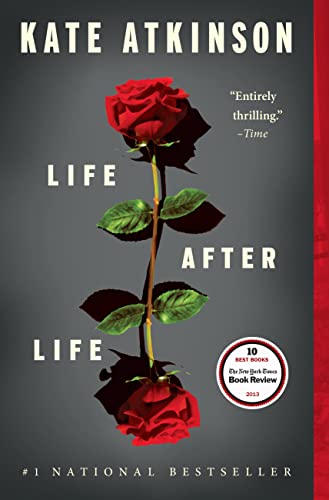Ever wondered what it would be like to get endless do-overs, like a video game with no rage-quits? Well, in this review, I’ll tell you all about a book that lets its main character keep hitting the restart button on life. ‘Life After Life’ takes the idea of second chances and runs wild with it—think less “yawn, another day” and more “wait, haven’t I died here before?” There’s family drama, war, and weird timey-wimey stuff, plus I got sucked in so deep I nearly missed lunch. So, is it worth your precious reading hours? Let’s crack on and find out.
In a nutsheel
Kate Atkinson’s Life After Life is a blend of historical fiction and drama with a twist of the weird. The story follows Ursula Todd, a woman who keeps restarting her life. Yup, if you mess up, you get another go at it. If only that worked for my attempts at baking sourdough.
The book is set in England across the first half of the 1900s. It covers big events like World War I and II, but it’s not just about the bangs and booms. Atkinson digs into fate, choices, second chances, and the wild idea of what our lives could be like if we just took a different bus (or in my case, ate a different breakfast).
This one is for folks who like their stories with a bit of time-bending, family drama, and a few life lessons snuck in between all the fun. If you like wondering about ‘what ifs’, this book will give you plenty to chew on.
Ursula’s Wild Ride: Choices, Chances, and All That Jazz in ‘Life After Life’
Kate Atkinson’s Life After Life gives us Ursula Todd, who has more reboots than my old laptop. Honestly, if I had a pound for every time she came back to life, I’d probably stop reviewing books and move to Barbados. Ursula’s many lives are like those video game respawns where you think, “Hey, I’ll do better this round!” She gets to restart at key moments, which leads to all kinds of wild decisions—some smart, some you really want to shout at her about. One life, she’s chasing down Hitler (yeah, that Hitler), while in another, she’s just trying to survive the world’s worst snowstorm.
Every life brings her a set of new choices. Will she turn left or right? Will she eat the dodgy egg salad sandwich or skip it and avoid food poisoning? (Okay, that last part might be more my own tragic story, but you get the gist.) Atkinson makes Ursula’s choices feel real—sometimes she’s brave, sometimes she’s scared, and sometimes she just wants a cup of tea. The big question hangs over every page: If you could do things over, would you change them, and would it even matter?
But let’s not forget, with all these lives and choices, things get a bit twisty. If you’re prone to confusion (like me when reading IKEA manuals), you might find yourself flipping back to check what just happened. Still, it’s all part of the fun, like playing Monopoly with a six-year-old who keeps changing the rules.
Next, we’ll untangle the family web, exploring Ursula’s siblings and all the joys and dramas that come with them—no psychic abilities required, just good old-fashioned nosiness!
Brotherly Love and Sisterly Sass: Family in Life After Life
If you think your family is a handful, you haven’t met the Todds. In Kate Atkinson’s Life After Life, the Todd family is the kind of lively, bickering English brood that makes your own Thanksgiving look like a silent retreat. Every page feels like you’ve been handed a mug of strong tea, then someone throws it across the room just to keep things interesting.
Atkinson knows her way around sibling drama. Ursula, our unlucky (or lucky?) lead, navigates her many lives with a motley crew of siblings. There’s Maurice, who’s so annoying that I was convinced I’d met him at one of my high school reunions. There’s Pammy, whose kindness makes my own sister look like a Bond villain. The Todd siblings bicker, support, and sometimes ignore each other—just like a real family. Atkinson captures those wild ups and downs in a way that had me texting my brother, “Sorry for the time I hid your shoes.”
But it’s not all laughs and eye-rolls. The novel shows how family shapes Ursula’s sense of herself, for better or worse. Every sibling squabble and parental meltdown nudges her along a new path. Even when things get tense (and trust me, Atkinson makes things very tense), you get the sense that love—strange, stubborn love—keeps the Todds together, even as the world around them starts to shake.
Atkinson doesn’t sugarcoat. She gives us all the mess, the warmth, and the sometimes spectacular failures. She reminds us that, whether you’re reliving life or just Sunday lunch, your family is the one thing you never really escape. And speaking of not escaping, let’s see how war barges through the Todd’s front door in the next section!
The War That Changed Everything: How Conflict Shapes Daily Moments in ‘Life After Life’
Let me tell you, Kate Atkinson sure knows how to make you feel the grind of war. In ‘Life After Life’, the bombs don’t just fall from the sky, they land smack in the middle of afternoon tea, interrupt polite conversation, and send shrapnel through those sweet memories of the old days. This isn’t just a “Sirens in the distance” type of story—Atkinson plops you right into the kitchen, ration book in hand, with nerves twitching at every window rattle.
One thing I love (and maybe fear?) about this book is how vividly it describes the everyday panic and the creative ways folks try to keep some normalcy. You want to make toast, but the power’s gone. You want to get milk, but the shops are rubble. And let’s not even start on the blackout curtains—those things seem like the real enemy sometimes. I could almost smell the mildew and taste the spam. The Todd family, especially Ursula, really deals with the constant uncertainty, and let me say, I even felt anxious for my own cupboards after reading about all the shortages.
Atkinson nails the little details, like neighbours passing rumors in hushed voices or children playing in bombed-out streets, which made me wonder if I should appreciate my boring, peaceful block a bit more. Still, sometimes the misery gets heavy—there are moments I wished for a few more laughs or silly bits to lighten the load, but hey, war isn’t exactly a pie-eating contest.
Next up: If you think life is simple, wait till you read about time doing the cha-cha with Ursula—let’s get loopy with the book’s wild structure!
How the Unique Structure of ‘Kate Atkinson Life After Life’ Keeps You Guessing
I have to admit, I have a soft spot for books that mess with time. ‘Kate Atkinson Life After Life’ is the poster child for this kind of thing. It doesn’t follow a straight path. Nope. Instead, it loops, twists, and throws you back in time like you hit rewind on your old VHS player (if you know, you know). Ursula, the main character, gets to live her life over and over, each time with a new spin. It’s a bit like being stuck in a never-ending game of “what if?”—which, let me tell you, can be both addictive and a touch confusing if you’re reading late at night with too little sleep.
Atkinson doesn’t just play with time because it’s fun (though I bet she had a blast). She uses it to ask big questions. Can we fix our mistakes? Are small choices really that powerful? I caught myself thinking about all the times I wish I could take a second shot at something. (Like the time I thought it was a good idea to try cooking with a smoke alarm as my timer. Spoiler: it was not.)
The structure keeps you on your toes. Just when you settle in, boom! New timeline. It’s a little like reading a choose-your-own-adventure, but someone else is flipping the pages. Some readers might find the jumping around jarring, but I think it adds a spark that makes ‘Life After Life’ shine.
Would I recommend it? Absolutely! Just be ready for a wild, twisty journey that might leave you questioning your own life’s replays.
Conclusion
Alright folks, that wraps up my review of Life After Life by Kate Atkinson! If you’ve ever wished for a redo button when you spill coffee on your shirt before work, this book is your spirit animal. Atkinson’s clever use of time loops keeps you guessing, and watching Ursula’s choices pile up feels a bit like my attempts at assembling IKEA furniture—mistakes, triumphs, and a lot of do-overs. The family drama is top notch (sibling bickering included), and the war era feels raw and real.
Still, the jumpy timeline and constant resets might leave some readers scratching their heads, or looking for a flowchart. If you like books that colour outside the lines, and don’t mind being a little confused now and then, this is a solid pick. Thanks for hanging out with me for this review. See you next time—hopefully with less existential crisis and more snacks!


